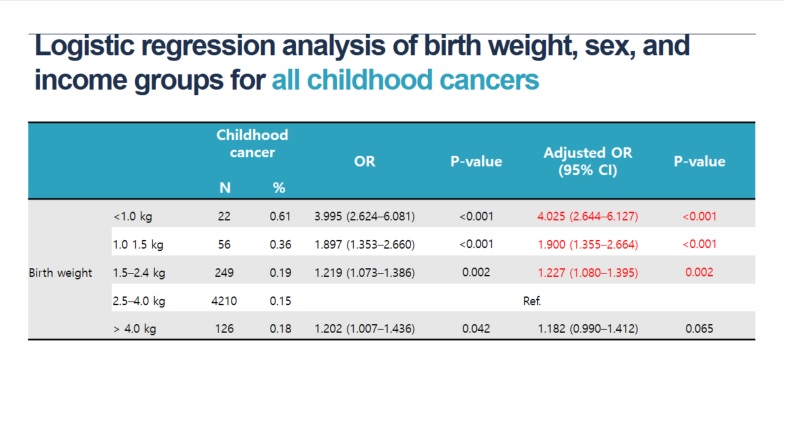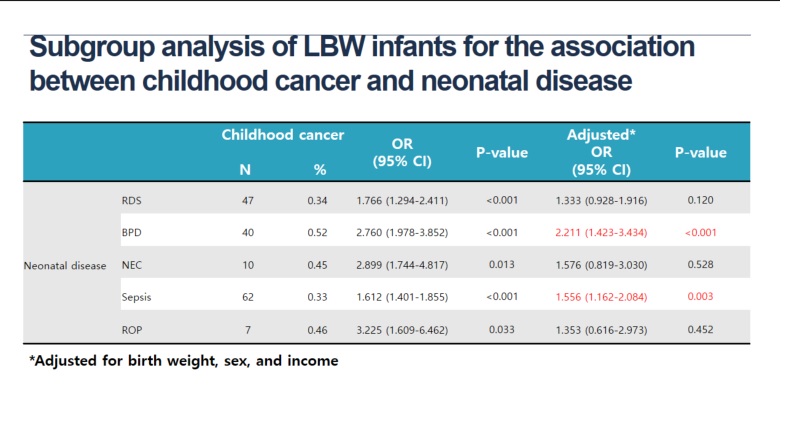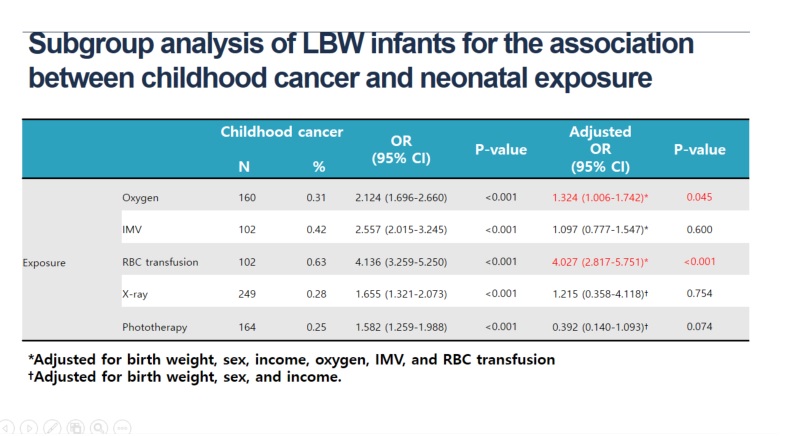Neonatal General
Neonatal General 10: Outcomes
68 - Risk of Childhood Cancer According to Birth Weight Using Database of the National Health Insurance Service in Republic of Korea
Publication Number: 68.429
- EJ
Euiseok Jung, MD. PhD. (he/him/his)
Associate professor
Asan Medical Center
Seoul, Seoul-t'ukpyolsi, Republic of Korea
Presenting Author(s)
Background: An increasing number of prematurely born survivors are transitioning through infancy, and childhood. However, there are few studies on the incidence of childhood cancer related to their birthweight.
Objective: This study aimed to determine whether there was an association between birth weight and the incidence of childhood cancer. Databases of the National Health Insurance Service (NHIS) and the National Health Screening Program for Infants and Children in Korea were used for the analysis.
Design/Methods: This retrospective study included all live births between 2008 and 2014. Infants without documented birthweight (including death), with chromosomal anomalies, and those with inaccurate birth weight records were excluded from the study. Birthweight of subjects was categorized into four groups: < 1.5 kg; 1.5–2.4 kg; 2.5–4.0 kg (normal birthweight, NBW); and >4.0 kg. Cancer was defined as a malignant neoplasm of ICD-10 code and participation in beneficiary of NHIS. Outcomes were adjusted for sex, history of perinatal diseases, and levels of income by multivariate logistic regression analysis. Subgroup analysis of LBW infants was conducted to determine the association of neonatal disease and exposure with childhood cancer.
Results:
During the study period, 3,244,083 surviving infants were identified in the database. Total occurrence of cancer was highest in the birthweight < 1.5 kg group (0.36%), compared with infants of birthweight 1.5-2.4 kg (0.19%) and the NBW group (0.15%). Univariate logistic regression analysis showed that infants born with lower or higher birthweight than NBW and male were associated with childhood cancer. In the multivariate analysis, birthweight < 1.0 kg (aOR 4.025, 95% CI 2.644–6.127), 1.0–1.4 kg (aOR 2.397, 95% CI 1.841–3.222), 1.5–2.4 kg (aOR 1.227, 95% CI 1.080–1.395) and male (aOR 1.182, 95% CI 1.071–1.203) were associated childhood cancer. Leukemia had a higher risk for birth weight >4 kg and boys, CNS malignancy had a higher risk for birthweight 1.5–2.4 kg, and hepatoblastoma had a higher risk for birthweight less than 1.5 kg and the medical aid. Subgroup analysis of infants with low birthweight (LBW, < 2.5 kg) showed that neonatal diseases such as bronchopulmonary dysplasia (aOR 2.211, 95% CI 1.423–3.434) and sepsis (aOR 1.556, 95% CI 1.162–2.084) and higher exposure to oxygen and red blood cell transfusions were associated with the development of childhood cancer.
Conclusion(s):
In this national big data analysis, LBW was associated with childhood cancer, specified by neonatal morbidity and treatment to which LBW infants may be exposed during the neonatal period.


